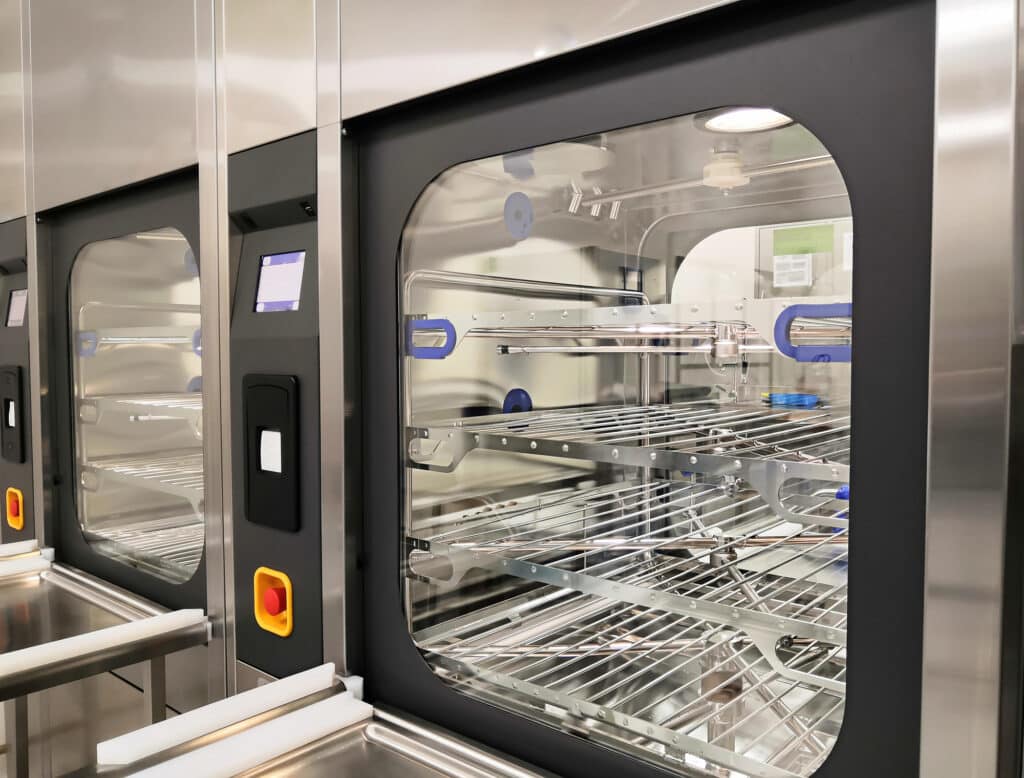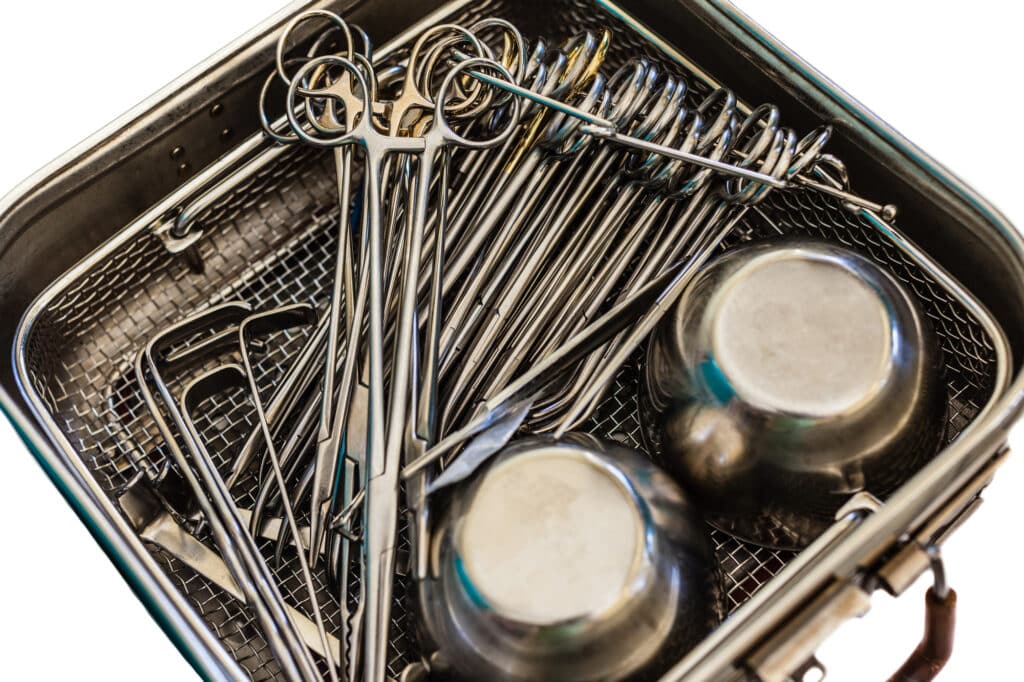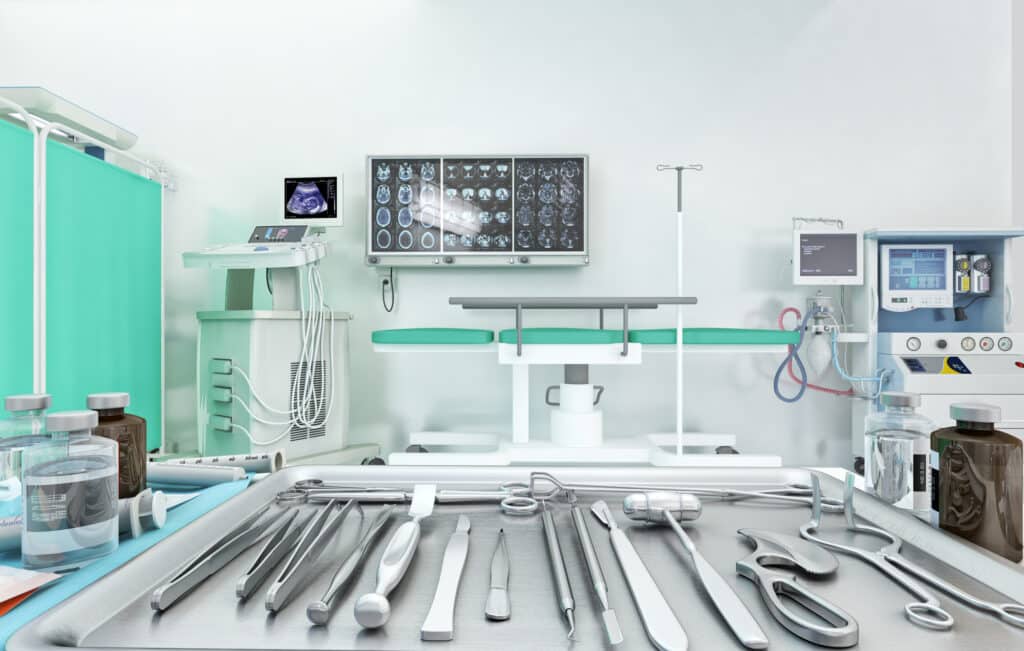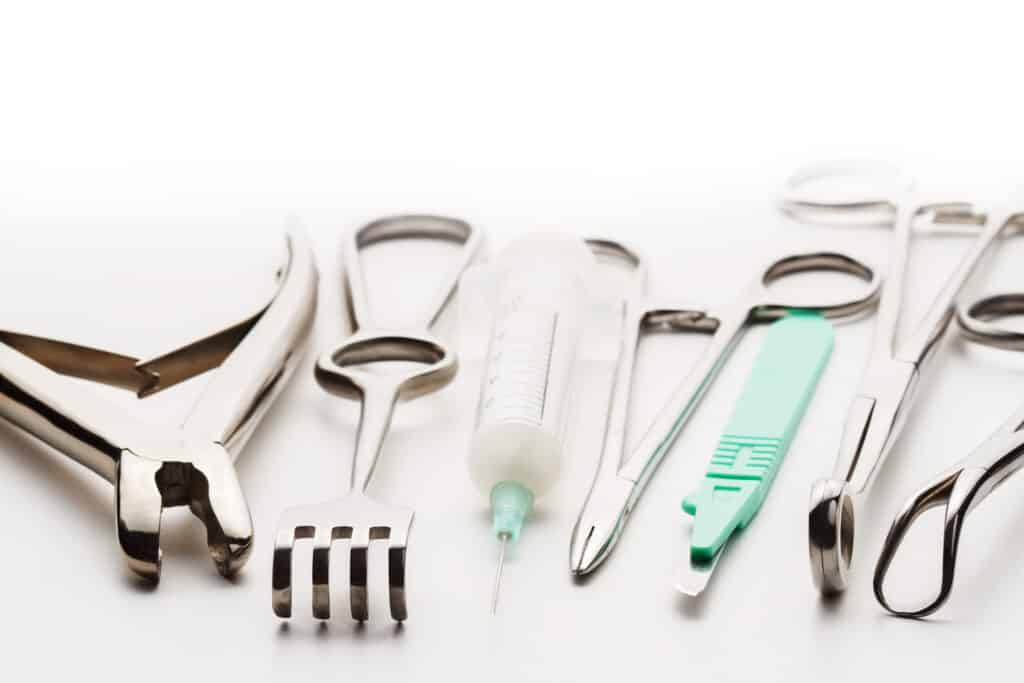Sterile Processing Equipment: Essential Instruments and Solutions
Sterile processing is a critical aspect of healthcare, playing a vital role in patient safety and infection prevention. From surgery centers to dental practices, the importance of maintaining a clean and sterile environment cannot be overstated. We will explore the essential sterile processing equipment used in these settings, discuss the various applications of this equipment, and delve into quality assurance and cost-effective solutions to ensure optimal performance and patient safety.
Short Summary
-
- Sterile processing is essential for patient safety and prevention of infections in healthcare settings.
-
- Key sterile processing equipment includes autoclaves, electro-steam generators, and washer-disinfectors.
-
- Quality assurance and sterility maintenance are critical components with cost effective solutions such as equipment maintenance/upgrades & refurbishing available to reduce costs while maintaining cleanliness & sterility.
The Importance of Sterile Processing

Sterile processing is paramount in ensuring patient safety and preventing the spread of infections in healthcare settings. The processes involved in sterile processing include cleaning, sterilization, and the maintenance of sterility until use. Surgical processing technicians play a crucial role in guaranteeing the successful completion of sterilization, which may involve the use of ethylene oxide for certain types of equipment.
Adherence to guidelines such as AAMI and FGI is essential for maintaining the highest standards of sterilization, reducing costs associated with infections and equipment replacement. STERIS reprocessing solutions offer valuable safeguards for surgical instruments, improving efficiency and ensuring the safety of patients and staff, including those working in the decontamination area.
The Central Sterile Supply Department (CSSD) is responsible for ensuring all equipment from all departments is free from contamination.
Key Sterile Processing Equipment
Sterile processing typically involves the use of the following equipment:
-
- Washers
-
- Sterilizers / Autoclaves
-
- Electro-steam generators
- Washer-disinfectors
Washers
Ultrasonic washers are employed to effectively eliminate fine stains and soils from medical instruments. Decontamination facilities are designed with a two-zone, one barrier configuration consisting of a Soiled/Decontamination Zone and a Washer/Disinfector Unloading Zone.
Ultrasonic washers work by converting sound waves into mechanical vibrations, forming microscopic bubbles on the items’ surface area, which generate small yet powerful vacuums upon bursting.
This section will provide a more in-depth look at three essential types of sterile processing equipment: autoclaves, electro-steam generators, and washer-disinfectors. Each of these pieces of equipment plays a vital role in maintaining a sterile environment, ensuring instruments and equipment are properly cleaned and sterilized before use.
Autoclaves
Autoclaves are machines that utilize high-temperature steam and pressure to sterilize items, eliminating microorganisms such as bacteria, viruses, fungi, and spores. They employ high-pressure steam to sterilize medical instruments and equipment, reaching temperatures of 121-134°C, sufficient to destroy any bacteria or other pathogens present. Autoclaves are:
-
- Effective
-
- Efficient
-
- Easy to use
-
- Require minimal maintenance
Various types of autoclaves are available, such as benchtop, floor-standing, and portable autoclaves. Each type of autoclave is designed to serve a specific purpose and has its own unique features and benefits, catering to different sterilization needs.
Electro-Steam Generators
Electro-steam generators are factory-assembled and wired units designed to generate steam, providing exact temperature regulation, energy efficiency, and sanitary, dry steam for sterilization processes. They utilize electricity to heat water, which is then transformed into steam and used for sterilization.
Electro-steam generators are employed in a range of contexts, such as:
-
- Surgery centers
-
- Dental offices
-
- General healthcare
-
- Central sterile departments
-
- Pharmaceutical production
-
- Laboratory research
-
- Custom applications
Their precise temperature control and energy efficiency make them a valuable asset in maintaining a sterile environment.
Washer-Disinfectors
Washer-disinfectors are devices that combine washing, disinfection, and drying processes to effectively clean and sterilize medical instruments that are both heat-sensitive and heat-resistant. Tunnel washers, for example, are equipped to execute:
-
- Pre-rinse
-
- Wash
-
- Ultrasonic cleaning
-
- Rinsing
-
- Drying
These processes require minimal to no human intervention, primarily facilitating hand-off processing. Supervision is essential to ensure tunnel washers are functioning in accordance with specifications.
By combining these processes, washer-disinfectors provide a streamlined solution for cleaning and sterilizing medical instruments, reducing the risk of microbial contamination and ensuring the safety and effectiveness of healthcare procedures.
Sterile Processing Equipment Applications

Sterile processing equipment is utilized in various healthcare settings, including:
-
- Surgery centers
-
- Dental practices
-
- General healthcare facilities
-
- Sterile processing department in central sterile departments
-
- Pharmaceutical production
-
- Laboratory research
Each of these settings, including the operating room, has its own unique requirements and challenges, making the role of sterile processing equipment crucial in maintaining a clean and safe environment for patients and staff.
The following subsections will discuss the specific applications of sterile processing equipment in each of these settings.
Surgery Centers
In surgery centers, sterile processing equipment is of utmost importance to ensure that surgical instruments and equipment are effectively cleaned, sterilized, and maintained. Autoclaves, electro-steam generators, and washer-disinfectors are utilized in these settings, playing a crucial role in avoiding infections, guaranteeing patient safety, and sustaining the productivity of surgical procedures.
Sterile processing equipment is employed in surgery centers for various applications, such as dental, general healthcare, central sterile departments, pharmaceutical production, laboratory research, and custom applications. To ensure quality and maintenance of sterile processing equipment in surgery centers, sterilization packaging, quality control and monitoring, equipment maintenance and upgrades, and equipment refurbishing are implemented.
Dental
Dental practices rely on sterile processing equipment to clean and sterilize dental instruments, protecting patients from cross-contamination. Autoclaves, electro-steam generators, and washer-disinfectors are commonly used in dental practices for this purpose. HALYARD Sequential Sterilization Wrap, for example, is designed to provide optimal protection against microbial contamination and is user-friendly.
Utilizing sterile processing equipment in dental practices can help minimize the likelihood of cross-contamination and guarantee patient safety. This ensures that dental procedures are carried out in a clean and safe environment while maintaining the highest standards of patient care.
General Healthcare
General healthcare facilities use sterile processing equipment to maintain a clean and safe environment for patients and staff. The importance of sterile processing equipment in general healthcare facilities is paramount, as it facilitates the reduction of infection and contamination risks and guarantees that medical instruments and supplies are properly sterilized and ready for use.
Central Sterile Departments
Central sterile departments in hospitals play a crucial role in ensuring the cleanliness and sterility of medical instruments and equipment. They utilize a range of sterile processing equipment, including autoclaves, electro-steam generators, and washer-disinfectors.
Sterile processing equipment is employed for various applications within central sterile departments, such as surgery centers, dental offices, general healthcare facilities, pharmaceutical production, laboratory research, and custom applications. Quality assurance and cost-effective solutions for sterile processing equipment include sterilization packaging, quality control and monitoring, equipment maintenance and upgrades, and equipment refurbishing.
Pharmaceutical Production
Pharmaceutical production facilities require sterile processing equipment to maintain a contamination-free environment for the production of medications. Autoclaves, electro-steam generators, and washer-disinfectors are commonly used in pharmaceutical production for this purpose.
Sterile processing equipment is essential for aseptic manufacturing processes and is a fundamental element in satisfying regulatory requirements for pharmaceutical production. Quality assurance and sterility maintenance measures for sterile processing equipment in pharmaceutical production include:
-
- Sterilization packaging
-
- Quality control and monitoring
-
- Equipment maintenance and upgrades
-
- Equipment refurbishing.
Laboratory Research
Laboratory research settings use sterile processing equipment to maintain a sterile environment for experiments and research activities. Autoclaves, electro-steam generators, and washer-disinfectors are employed in these settings to ensure aseptic conditions.
Sterile processing equipment is utilized in laboratory research settings for various applications. To ensure quality assurance and sterility maintenance of sterile processing equipment in laboratory research settings, measures such as sterilization packaging, quality control and monitoring, equipment maintenance and upgrades, and equipment refurbishing are implemented.
Custom Applications

Custom applications of sterile processing equipment provide tailored solutions designed to meet the distinct requirements of diverse industries and settings. These tailored solutions can be adapted to fulfill the unique needs of various industries and settings by considering factors such as facility size, equipment requirements, and the environment in which the equipment will be used.
Examples of custom applications in different industries and settings include autoclaves for surgery centers, washer-disinfectors for dental offices, and electro-steam generators for general healthcare facilities.
Custom applications of sterile processing equipment can be designed to suit the distinct requirements of various industries and settings, ensuring the highest standards of cleanliness and sterility.
Quality Assurance and Sterility Maintenance
Quality assurance and sterility maintenance are essential aspects of sterile processing, including sterilization packaging and quality control monitoring. Ensuring that sterile processing equipment is properly maintained and monitored is crucial for maintaining a clean and safe environment in healthcare settings. To maintain sterility, it’s important to follow best practices and guidelines for sterilization.
This section will discuss the importance of sterilization packaging and quality control monitoring in maintaining the effectiveness of sterile processing equipment and ensuring compliance with industry standards.
Sterilization Packaging
Sterilization packaging plays a crucial role in protecting medical instruments and equipment during storage and transport, ensuring they remain sterile until use. Sterilization packaging includes materials and methods such as:
-
- Sterilization pouches
-
- Peel packs
-
- Flat wrappers
-
- Sterilization containers
These enable the penetration of sterilizing agents while retaining the sterility of the contents until they are ready for use.
Various types of sterilization packaging are available, catering to the specific needs of different healthcare settings and ensuring that medical instruments and equipment remain sterile and protected from contamination. Proper sterilization packaging is an essential aspect of quality assurance and sterility maintenance in sterile processing.
Quality Control and Monitoring

Quality control and monitoring processes help maintain the effectiveness of sterile processing equipment and ensure compliance with industry standards. These processes involve:
-
- Evaluating and inspecting products, services, or processes at various stages of production or delivery
-
- Detecting any deviations or defects
-
- Taking corrective actions to address any issues
By implementing these quality control and monitoring processes, facilities can ensure that their sterile processing equipment is functioning properly and meet necessary industry standards.
The advantages of quality control and monitoring include enhanced product quality, heightened customer satisfaction, and decreased costs due to fewer imperfections and the need to reprocess equipment. Implementing quality control and monitoring processes in sterile processing ensures that equipment functions optimally and adheres to industry standards, ultimately contributing to a clean and safe environment for patients and staff.
Cost-Effective Solutions for Sterile Processing
Cost-effective solutions for sterile processing, such as equipment maintenance, upgrades and equipment refurbishing, assists healthcare facilities to reduce costs while maintaining the highest standards of cleanliness and sterility.
The next section will discuss the benefits of these cost-effective solutions and provide actionable implementation tips in healthcare settings.
Equipment Maintenance and Upgrades
Regular maintenance and upgrades of sterile processing equipment can extend its lifespan, improve performance and reduce overall costs. Maintenance involves routine inspections, testing, and repairs to prevent equipment downtime and ensure optimal performance. Upgrades involve improving or replacing certain components or systems of the equipment to enhance its functionality, efficiency, or lifespan.
Carrying out regular maintenance and upgrades can help diminish downtime, enhance safety, and boost efficiency. It is essential to use appropriate tools and techniques for maintenance and upgrades, including proper instrument management and following manufacturer’s instructions to guarantee optimal performance.
Equipment Refurbishing
Buying refurbished or reconditioned sterile processing equipment can provide a cost-effective alternative to purchasing new equipment while maintaining high standards of cleanliness and sterility. The process of equipment refurbishing includes:
-
- Disassembling the equipment
- Thoroughly cleaning and inspecting the parts
- Replacing any worn or damaged parts
- Reassembling the equipment
Purchasing refurbished sterilizers from a trusted and reputable source is crucial for ensuring the safety and effectiveness of the sterilization process in medical or laboratory settings. At PM Medical, we adhere to stringent quality control measures, ensuring that the refurbished equipment meets or exceeds original manufacturer specifications.
Quality assurance is essential in equipment refurbishing to guarantee that the equipment is returned to its original condition and abides by all safety and performance criteria. By opting for refurbished equipment, healthcare facilities can save on costs while ensuring that their sterile processing equipment remains effective and reliable.
Summary
Sterile processing is a critical aspect of healthcare, playing a vital role in maintaining a clean and safe environment for patients and staff. From essential equipment such as autoclaves, electro-steam generators, and washer-disinfectors, to various applications in surgery centers, dental practices, and general healthcare facilities, sterile processing is integral to ensuring patient safety and infection prevention. By implementing quality assurance measures, cost-effective solutions, and maintaining sterility through proper packaging and monitoring, facilities can uphold the highest standards of cleanliness and sterility for the well-being of patients and staff.
Frequently Asked Questions
What is sterile processing?
Sterile Processing is an essential process to ensure medical instruments are safe and sterile for use during surgical procedures. Technicians oversee the process of cleaning, inspecting, disinfection and sterilization of the devices to ensure safety standards are met.
The process begins with the cleaning and decontamination of the instruments, which is done by hand or with an automated washer. After cleaning, the instruments are inspected for any damage or defects, run through sterile processing equipment, and then placed in sterile storage for later use.
What machines are used in sterile processing?
Sterile processing equipment typically includes decontaminators, ultrasonic washers, tunnel washers, cart washers, steam sterilizers, sterile processing department accessories, sterilization pouches and trays, and V-PRO low temperature sterilization systems.
These are essential for ensuring medical instruments and supplies are properly sterilized and safe for use. They are used in hospitals, clinics, and other medical facilities to ensure all instruments and supplies are free of bacteria and other contaminants.
What are the 3 most common machines used in sterilization?
What is sterile equipment?
Sterile equipment refers to medical devices such as surgical instruments, biopsy forceps and implanted medical devices which must be sterile in order to prevent any potential microbial contamination leading to disease transmission.
Through a process of cleaning, disinfection, and sterilization, equipment is sterilized before use to ensure they are free from any microorganisms that could cause infection. These processes of sterilization often involve the use of heat, chemicals, or radiation.
What are the 3 major physical areas of a typical sterile processing department?
The three major physical areas of a typical sterile processing department are Decontamination, Prep/Pack/Clean, and Sterile Stores. These areas allow for efficient process workflow by providing necessary functions such as decontamination, assembly and sterile processing, sterile storage, and distribution.